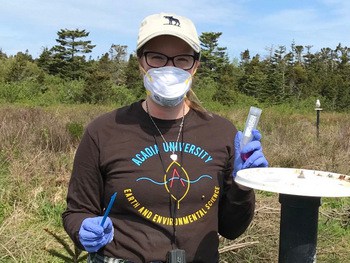
Biovectors can transport contaminants to remote locations through excretion, shedding feathers and decomposition of carcasses. Big Meadow Bog on Brier Island is home to nearly 3000 mating pairs (2019) of herring gulls (Larus argentatus) each year during their nesting season (April-August). Mercury is a concern in food webs as it can cause irreversible effects to the nervous and reproduction systems in organisms. The presence of migratory seabirds may influence the mercury and nutrient biogeochemistry in this wetland.
Five plastic posts were deployed in Big Meadow Bog for birds to excrete on. More than 50 samples were collected between May and August 2018-2019, in biweekly increments. Samples were dried, homogenized and analyzed for total mercury directly. Extractable phosphate, nitrate and sulphate were
also measured.
Analysis equipment will be used from both Nelson O’Driscoll and Jennie Rand’s laboratories.
It is still unknown if gulls alter the mercury cycle directly from concentrations in their feces or by providing nutrients to microbial processes that transform mercury speciation. This study aims to quantify the annual deposition rates of mercury and nutrients being introduced to Big Meadow Bog by herring gulls. This research is not only significant for conservation of this wetland but many other locations worldwide that are influenced by migratory seabirds.


 Acadia University
Acadia University